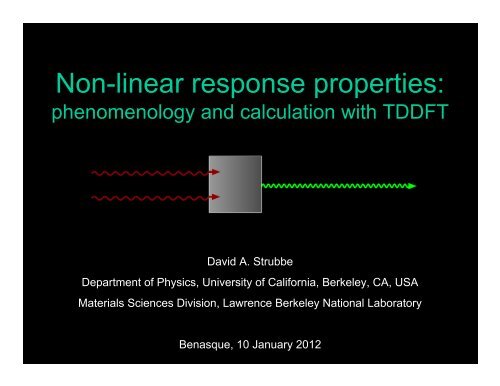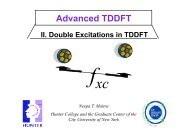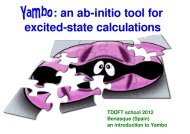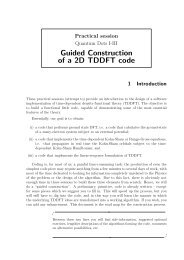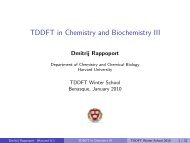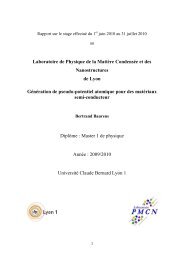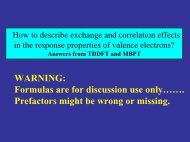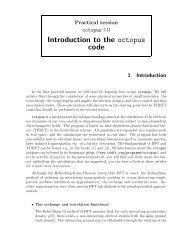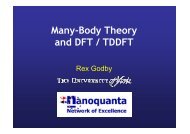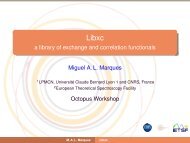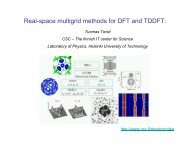Non-linear response properties: - TDDFT.org
Non-linear response properties: - TDDFT.org
Non-linear response properties: - TDDFT.org
You also want an ePaper? Increase the reach of your titles
YUMPU automatically turns print PDFs into web optimized ePapers that Google loves.
What is non-<strong>linear</strong> optics?Polarizability (<strong>linear</strong> optics)absorption, refractionHyperpolarizability: second-harmonic generation (SHG) etc.Consider only perturbative processes via Taylor expansion of dipole moment.Not high-harmonic generation!
Quantized picture of non-<strong>linear</strong> opticsabsorptiontwo-photon absorptionrefractionsecond-harmonic generation
A zoo of non<strong>linear</strong> optical processessum-frequency generation (SFG)difference-frequency generation (DFG)second-harmonic generation (SHG)optical rectificationPockels (electrooptic) effectthird-harmonic generation (THG)two-photon absorptionfour-wave mixingEnergy conservation requires frequency arguments to sum to zero.
ApplicationsCharacterization in surface science and chemistry (very sensitive)Optical parametric amplifiersPockels cellsLaser pointersTunable light sourcesOptical logiccoherent anti-Stokes Raman spectroscopy (CARS) (kind of 4-wave mixing)Two-photon fluorescencing labels in biologyTypically in<strong>org</strong>anic crystals are used in applications, but <strong>org</strong>anic moleculeshave the potential to be cheaper and more efficient.
SHG and SFG at the National Ignition FacilityLawrence Livermore National Laboratory, Livermore, California600 KH 2 PO 4 crystals of 400 kg each, ultrapure to avoid absorption.192 laser beams for inertialconfinement fusion1053 nm1053 nm1053 nm527 nm351 nmTotal power = 500 TW
The challenges of non<strong>linear</strong> optics: a cautionary taleThe original experimental report of SHG (quartz, 694 nm)Lesson: check your proofs!
Symmetry <strong>properties</strong> of non<strong>linear</strong> susceptibility tensorsInversion symmetry: even orders are zero (µ, β, δ, etc.).Apply inversion:ThereforeHence surface-sensitive if bulk is centrosymmetric.Permutation symmetry:Also Kramers-Kronig relations.“Kleinman symmetry,”Only for
Symmetry <strong>properties</strong> of non<strong>linear</strong> susceptibility tensorsSpatial symmetries: e.g. chloroform (CHCl 3 )µ i α ij β ijkZincblende structure (e.g. GaAs) has only
Conventions and unitsMany conventions for pre-factors! Multiple papers on just conventions…Commonly used units: au, esu1 au of β= 3.206361×10 −53 C 3 m 3 /J 2 (SI)= 8.6392×10 −33 cm 4 statvolt −1 (esu of β)A. Willetts, J. E. Rice, D. M. Burland, and D. P. Shelton,J. Chem. Phys. 97, 7590 (1992)
<strong>Non</strong><strong>linear</strong> optics in solidsSusceptibility tensors for solidsNow can have q-dependence as well.Phase-matching condition for constructive interference:(NOT momentum conservation)Adjust angle of incidence to satisfy and get significant conversion.Molecules vs solids: orders of magnitude.KTiOPO 4χ (2) ~ 10 -8 esuβ ~ 10000 auCHCl 3β ~ 1 au, χ (2) ~ 10 -8 esu
Other perturbationsIonic displacement and strain (Raman tensors, Grüneisen parameters,phonon anharmonicity, pyroelectric tensor, piezoelectric tensor, secondorderelastic coefficients, …)S. Baroni, S. de Gironcoli, A. Dal Corso, and P. Gianozzi,Rev. Mod. Phys. 73, 515 (2001)Magnetic contributions to non<strong>linear</strong> optical processes.But usually electric-dipole approximation is sufficient!Representation of electric field in finite and periodic systems:Quantum theoryof polarizationA Dal Corso, F Mauri, and A Rubio, Phys. Rev. B 53, 15638 (1996)
Solution measurements of hyperpolarizabilityMeasurements are usually in solution for molecules. Solvent effects can bestrong and complicate comparison between experiment and theory.(In theory, handle via polarizable continuum models or explicit solvent insmall clusters or periodic system.)(Time-averaged) inversion symmetry of solution makes ordinarymeasurement give zero.Electric-field-induced second-harmonic generation (EFISH) is coherentthird-order process, based on field lining up molecules.What is measured directly and often reported:Hyper-Rayleigh scattering (HRS) is incoherent second-order process,based on orientational fluctuations.
Solution measurements of hyperpolarizabilityConsider projection along dipole moment.Vertical-vertical and horizontal-vertical polarizations for experiment.
Vibrational / rotational contributionsMany measurements are at λ = 1064 nm. For <strong>org</strong>anic molecules, typically:- above vibrational frequencies, so can neglect vibrations- below electronic resonances so little dispersionRotational and vibrational contributions can be estimated from simpleharmonic models, for low-frequency <strong>response</strong> (e.g. THz).Z* = Born effective chargeD. Bishop, Rev. Mod. Phys. 62, 343 (1990)E. Roman, J. R. Yates, M. Veithen, D. Vanderbilt, and I. Souza, Phys. Rev. B 74, 245204 (2006)
Local-field factors for solventClausius-Mossotti relations,relate bulk to molecular susceptibilities.–––––++++––––Lorentz:+++++Also generalizations for ellipsoidal cavity, polar solvents.
Theoretical methods for non<strong>linear</strong> <strong>response</strong>1. Finite differences (static)2. Explicit time-propagation3. Sternheimer equation (2n+1 Theorem)4. Sum over states (Casida equation)5. Dyson equation
Finite differencesApply static fields and calculate dipole moment.No need for special capabilities in code.Probably most common method used.Hope static and IR are similar!fit or stencilCHCl 3F. Vila, D.A. Strubbe, Y. Takimoto, X. Andrade, A. Rubio, S. G. Louie, and J. J. Rehr,J. Chem. Phys. 133, 034111 (2010)
Convergence is more demanding for non<strong>linear</strong> <strong>response</strong>(aug-cc-pV5Z)(SIESTA)(h =0.25, r=22)F. Vila, D.A. Strubbe, Y. Takimoto, X. Andrade, A. Rubio, S. G. Louie, and J. J. Rehr,J. Chem. Phys. 133, 034111 (2010)Comparison of Gaussian-type orbitals, SIESTA numericalbasis sets, real-space grid: need five-zeta basis sets withdiffuse functions, or very long-range real-space grid.RResponse extends far from molecule (> 15 a 0 )Compare: only 12 a 0 converges ground stateall atoms contained within 3 a 0 radius
Explicit time-propagationCannot use “kick” for all frequencies at once (as for <strong>linear</strong> optics).Must calculate separately for each frequency combination.Scaling is like one ground-state calculation per time step.Incident laser pulses (duration ~ imaginary broadening).p-nitroanilineTakimoto, Vila, and Rehr, J. Chem. Phys. 127, 154114 (2007)
Explicit time-propagationTakimoto, Vila, and Rehr, J. Chem. Phys. 127, 154114 (2007)
Sternheimer equationaka density-functional perturbation theory or coupled perturbed Kohn-ShamCalculate variation of wavefunctions in <strong>linear</strong> <strong>response</strong>.No need for unoccupied states.One frequency at a time (but can use previous freq as starting point).SCF cycleNeed small imaginary broadening iη near resonances for numerical stability.
Sternheimer equation: 2n+1 TheoremSolving n th -order perturbation theory gives 2n+1 derivative of total energy.n = 0: Hellman-Feyman Theorem. No wavefunction derivatives at all.n = 1: Linear variation of wavefunctions gives quadratic <strong>response</strong>.X. Gonze and J.-P. Vigneron, Phys. Rev. B 39, 13120 (1989)Quantum ESPRESSO and Octopus use equations on previous slide.ABINIT formulation: find β by minimizing with respect to ψ (1) (variational).
Sternheimer equation: examples from Octopus codeH 2 O optical rectificationCO <strong>linear</strong>spectrumCO SHGX Andrade, S Botti, MAL Marques, and ARubio, J. Chem. Phys. 126, 184106 (2007)
Sternheimer equation: examples from Octopus codeEfficient scaling with system size: O(N 2 ), cheaper than ground state.e.g. comparison of TDLDA vs. CIS with Gaussian basis for vibrating N@C 60G. P. Zhang, D.A. Strubbe, S. G. Louie, and T. F. Ge<strong>org</strong>e, Phys. Rev. A 84, 023837 (2011)
Sum over statesApplicable to any method giving excited-state energies and matrix elements, inparticular Casida equation for <strong>TDDFT</strong>.(Also other theories such as configuration interaction, coupled cluster, Bethe-Salpeter equation, etc.)Most commonly used as RPA though: just use Kohn-Sham energies andmatrix elements.Arbitrary (or physical butunknown) imaginarybroadenings Γ.Convergence in two sumson states is difficult!Applied occasionally totwo-photon absorption in<strong>TDDFT</strong>.
Dyson-like equationEfficient scheme for solids (for <strong>linear</strong> and non-<strong>linear</strong> optics): k-points.Need q->0 limit, equivalent to k.p perturbation theory.Complicated macroscopic/microscopic relations…G. Senatore and K. R. Subbaswamy, Phys. Rev. A35, 2440 (1987)E. Luppi, H. Hübener, and V. Véniard, J. Chem. Phys.132, 241104 (2010)
Dyson-like equationMust converge with respect to unoccupied states in a triple sum.E. Luppi, H. Hübener, and V. Véniard, Phys. Rev. B 82, 235201 (2010)
Some references on non<strong>linear</strong> <strong>response</strong>DA Strubbe, L Lehtovaara, A Rubio, MAL Marques, and SG Louie, “Responsefunctions in <strong>TDDFT</strong>: concepts and implementation,” in Fundamentals of Timedependentdensity-functional theory (ch. 7) and references therein.Yuen-Ron Shen, The Principles of <strong>Non</strong><strong>linear</strong> Optics (Wiley 1984 / 2002).P. N. Butcher and D. Cotter, The Elements of <strong>Non</strong><strong>linear</strong> Optics (CambridgeUniversity Press, 1990).


